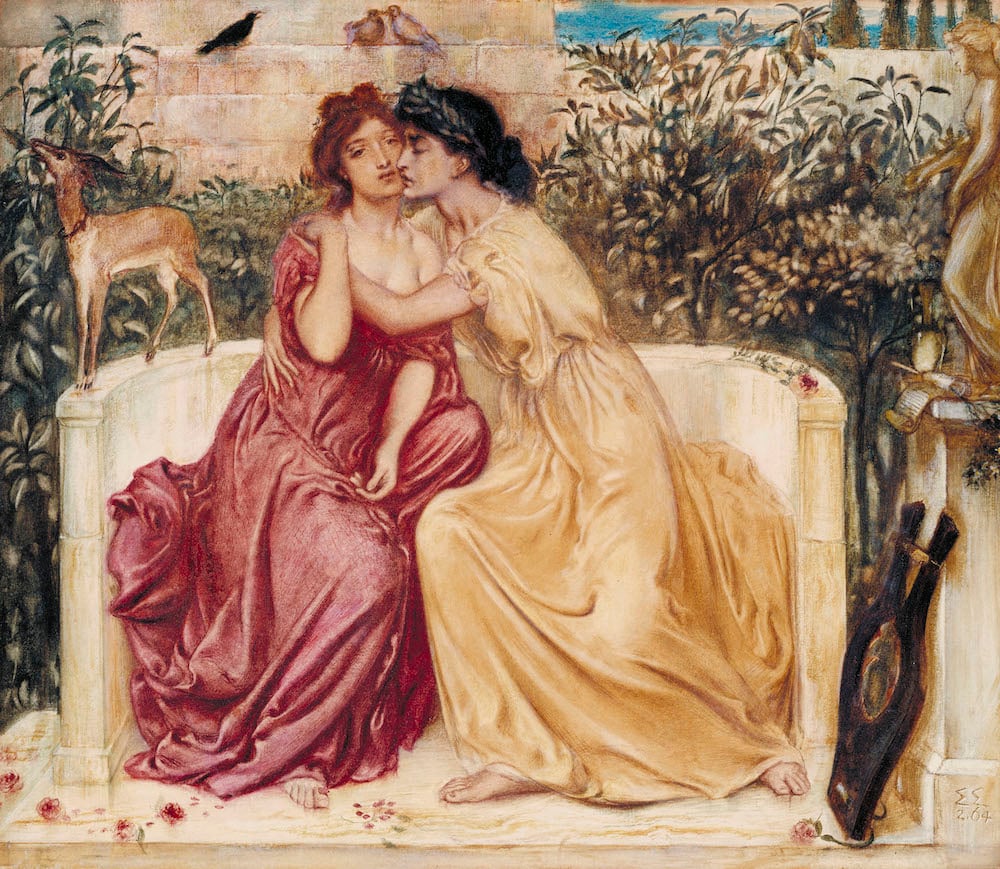
Her name alone means many things. Ancient Greek poet Sappho, who Plato proclaimed the Tenth Muse, inspired the adjective for media around women loving women. She pioneered an eponymous meter favored by Horace, too. Although she is held in the same esteem as Homer, much less of Sappho’s work survives today. On the rare occasion that new fragments of Sappho’s lost poetry appear, they spark frenzy amongst archaeologists, linguists, and lay readers alike.
Doubt dogs basic details of Sappho’s biography. Experts agree she was born in the 7th century B.C.E. on the island of Lesbos to well-off parents amidst a dynamic political and cultural era. Sappho’s work, though, focused on the interior—she wrote tender yet charged lines about love’s ravages, frequently pining for women.
The Poetess herself never mentioned a husband, but the Suda, a Byzantine encyclopedia of the ancient world, says she wed a man named Kerkylas of Andros. One poem mentions a daughter named Cleis, but the Paris Review notes that term also means “slave.” An “unfounded legend” states that Sappho threw herself into the sea over a ferryman. Other accounts claim she fled to Sicily for a period, but died in old age back home, among the cult of Aphrodite she was leading.
Sappho composed 10,000 lines of poetry over her lifetime, amassed at one point into nine books at the Library of Alexandria. Only 650 lines remain, across salvaged stanzas, sentences, and single words. At the height of her prominence, Sappho’s visage featured on vases, statues, and money, but the New Comedy school of Greek writers recast her in an unsavory light just several centuries after her death.
Even without their slander, her work would have suffered. Sappho didn’t write her poetry down, but sang it while playing the lyre. And by the time manuscripts proliferated, her Aeolic Greek dialect had fallen into obscurity—further hindering her oeuvre’s translation. Popular conspiracies blame Pope Gregory VII for ultimately ordering all her work burned in 1073, though one British scholar says, “It is unclear how a Roman Pope could command the destruction of texts in Constantinople after the great schism.”
What archaeologists have pieced together hails largely from other writers quoting Sappho. Society possesses but two full poems from her—one courtesy of the rhetorician Dionysius of Halicarnassus, who included Sappho’s “Ode To Aphrodite” as an elite standard in his treatise On Literary Composition.
Most pieces of Sappho’s poetry are found on notoriously volatile papyrus. Even pristine specimens are hard to translate, given the cramped way people once wrote. Her words have turned up on other materials too, but their lines require meticulous confirmation and reassembly. In 1880, Friedrich Blass published a parchment fragment found at Crocodilopolis. In 1937, four stanzas from another poem were found scrawled on a piece of ceramic.
The latest new fragments have popped up not from excavations, but in private collections. In 2002 the Cologne Papyrus Collection acquired 20 papyri that hit the market, completing almost five verses of another poem. In 2014, two previously unknown poems appeared among an anonymous, contested British collection. As for locating Sappho’s next pieces, researchers are betting on artificial intelligence to help.
The Hunt explores art and ancient relics that are—alas!—lost to time. From the Ark of the Covenant to Cleopatra’s tomb, these legendary treasures have long captured the imaginations of historians and archaeologists, even if they remain buried under layers of sand, stone, and history.